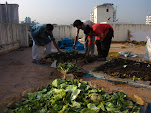A little more than a year-and-a-half since our last post.....we feel a bit guilty about this. Its almost as if coming out of the dressing room on to the stage in elaborate make-up and gear - you feel kinda funny wondering what people out there must be thinking.
Well....a lot of things have happened in the garden of our lives. For one, we now have a tiny (actually not so tiny now) human being crawling and cruising around in our home. As you can imagine most of our gardening efforts have been directed towards bringing to life and then nurturing this little creature.
At the same time, we have been a tad bit sad that we had to ignore our terrace garden, though unintentionally. But finally Shirish decided to shake things up, tighten his belt and put an extra effort into reviving the garden. So he went about getting some '
shen-khath' (cow-dung manure) from a cow-shed nearby and some soil from our land in Panchgani. He also decided to line all our crates with tarpaulin sheets (with holes pierced in them for water drainage) since the gap between the floor-boards had widened due to the warping of wood. This was causing a lot of soil-loss. And since the monsoons were almost upon us, this was a necessary measure. We then planted
Bhindi or Okra in one of the crates - this year we decided to plant a lot of it to fill one crate so that we would get sufficient harvest at one time for it to be usable. We also planted cucumber, beans, tomatoes and bottle gourd. The
bhindi did very well this year and we got continuous yields for about 2 months - really tender okra which cooked so easily. However, the tomatoes, beans and the bottle gourd did not sprout at all - disappointing! The cucumber sprouted and took a while to grow, but finally it did and we also got a few cucumbers - not a whole lot though.
But as always, we got a few pleasant surprises. We got a huge ash gourd, though we did not plant it.


We had planted some of our potatoes that had sprouted and they grew into healthy looking plants. But when we pulled them out this week, we found just 1 potato in each plant - a little disappointing again! Our biggest surprise though was a pineapple that we had planted 2 years back. It finally yielded a small but really sweet and juicy pineapple.
We now also have 3-4 creepers of bitter gourd that came up on their own and are yielding quite a regular supply.
One of our ignored plants was the colocasia (
arbi in hindi) - one of the varieties of which we were not sure whether it was edible. We had received mixed opinions from different people, basically leaving us confused. We finally did some internet search and then decided to try it out for ourselves and so we made '
alu wadi' using the colocasia leaves - this is a maharashtrian snack with layers of gram flour in-between the leaves rolled-up and steamed. Came out quite tasty the first time - so we have one more item on our terrace that we can eat now.
A couple of mustard plants had sprouted on their own in some of the pots and they have yielded about a cup-ful of mustard seeds. These ones really pop with a vengeance.
So looks like after a year-long hiatus our terrace garden is getting back to form. We are already planning our next planting for the post-monsoon season. Hopefully we will get around to getting the seeds and planting them before it is too late....and hope to update here soon too.





































